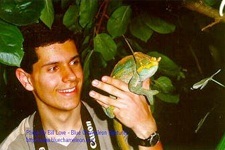



Words from the Editor
By Christopher V. Anderson, PhD
Citation:
Anderson, C.V. (2014). Words from the Editor. Chameleons! Online E-Zine, June 2014. (http://www.chameleonnews.com/14JunAndersonWFTE.html)
Dear Chameleons! Online E-Zine readers,
As usual, the time since the last issue was released has been longer than originally intended. I appreciate everyone’s patience and continued support and loyalty. The last few years have been incredibly busy for me, which has directly impacted putting out new issues. For a significant period of time, I was working on trying to complete my Ph.D., and work on conducting and publishing my research. Fortunately, last May (2013), I finished! Since last summer, I have been working as a postdoctoral research and teaching associate at Brown University. Needless to say, this has taken a considerable amount of time as well. Alas, I’ve finally gotten around to releasing a new issue, and you’ll all be pleased to know, I’m even working on the next issue as this one comes out!
Our first article for this issue is contributed by myself on the topic of the trade status of Rhampholeon spinosus. In recent years, this beautiful, small and endangered chameleon species from Tanzania has been subjected to huge levels of illegal trade. In a nutshell, this is a CITES listed species under its previous classification (CITES does not recognize the classification change from Bradypodion spinosum to Rhampholeon spinosus), but its reclassification as a Rhampholeon species, which are not themselves CITES listed, has created significant confusion about the protected status of this species. As a result, this endangered species has been subjected to uncontrolled collection and export for the pet trade without accompanying CITES documents. While illegal, the confusion about whether this species is subject to CITES regulations has enabled this species to be exploited at unfathomable levels. In this article, I try to document this situation and hopefully dispel any confusion once and for all.
Our next article comes from Rob Pilley. Rob is a chameleon keeper in the UK who keeps his Bradypodion thamnobates out in his greenhouse year round. In the winter, he utilizes an unconventional method whereby he allows his chameleons to go into a dormancy. This behavior is actually very common in some of the more temperate chameleon species in their natural habitat. In this article, Rob explains his husbandry techniques, including discussion of his strategy of allowing his chameleons to experience a winter dormancy.
Next, Carl Cattau has contributed an article on three different feeder items he has been culturing recently. These feeder items are smaller than a lot of the ones people typically culture, and between them include excellent food sources for small and neonate chameleons, as well as chameleons that are proving to be difficult feeders, themselves. In this article, Carl outlines how to culture green banana cockroaches, bean beetles, and aphids.
Dayna Willems, a vet and fellow chameleon keeper, has provided a review of a new book titled “The Biology of Chameleons”. This is a scholarly book that summarizes our current knowledge on the biology of these animals, and a must have for anyone seriously interested in chameleons. It is an edited text with chapters written by a variety of chameleon researchers from all over the world, including three chapters coauthored by myself. I’m very thankful for Dayna having been willing to provide a review of this book for everyone!
Finally, I have reviewed a new book titled “Mountain Dragons” by Jan Stipala. This is an excellent book outlining a year spent in the central and western highlands of Kenya studying the chameleons of the region. It is filled with exceptional photographs of a number of very rare and unusual species, including numerous locale specific photographs showing diversity in those species that has never been shown to this extent. This is a fantastic book that I think anyone would enjoy!
I’d like to encourage everyone to submit article ideas to me for future E-Zine issues. If there is an article you’d like to see, an author you think would be good to write it, or if you think you have an article you’d like to write, I’d love to hear from you and talk about getting it going. Even if English isn’t your native language, I’d be happy to help edit it with you.
Enjoy the new issue!
Chris Anderson
Editor

Christopher V. Anderson, PhD

Chris Anderson has a Ph.D. in Biology (Physiology & Morphology) from the University of South Florida’s Department of Integrative Biology, where he studied the effects of temperature on ballistic tongue projection and tongue retraction in chameleons for his dissertation. Currently a Postdoctoral Researcher at Brown University, Chris is also a member of the IUCN/SSC Chameleon Specialist Group. His chameleon research has been published in top scientific journals and books, and the results have been featured in popular press and news outlets all over the world. He has traveled extensively to chameleon habitats around the world, including conducting work with chameleons in Madagascar, South Africa and Cameroon, as well as introduced populations in Florida. Further, Chris has been keeping chameleons since 1997, and since then has worked with over 70 different species and subspecies in captivity. Currently, Chris is the Editor and Webmaster of the Chameleons! Online E-Zine. Chris’ personal website can be found at www.chamaeleonidae.com and he can be emailed at either Chris.Anderson@chameleonnews.com or Furcifer.minor@gmail.com.









Join Our Facebook Page for Updates on New Issues:
© 2002-2014 Chameleonnews.com All rights reserved.
Reproduction in whole or part expressly forbidden without permission from the publisher. For permission, please contact the editor at editor@chameleonnews.com
